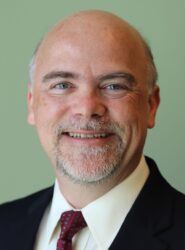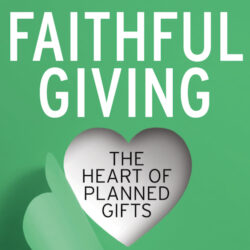Leadership and Planned Giving Efforts
Leadership and Planned Giving Efforts
by James W. Murphy, CFRE
Leadership is an important part of any new ministry that a congregation may undertake, regardless of its faith tradition: whether that be a new feeding program, youth group, or clergy search committee. When it comes to the religious work of raising financial resources for a congregation or small religious charity, choosing the wrong leader has impacts beyond diminished gifts, as numerous vital relationships could also be damaged. As elaborated in my new interfaith book Faithful Giving-The Heart of Planned Gifts (Church Publishing Inc. 2022), regardless of the tradition – Christian, Muslim, Jewish or Sikh – leadership is crucial for creating and maintaining a planned giving program.

You can even take a look at sample chapter on line, which review the importance of leadership in all planned giving efforts here under ‘Read an Excerpt.’
Senior leadership challenges
As most readers will know, planned giving focuses on encouraging the many different gifts made primarily out of one’s estate at death or from one’s retirement savings. Though smaller in number than annual gifts, they can be the largest gift an individual makes and is often transformational for that community of faith and the donor’s family. Regardless of future benefits, it can be difficult to get some religious leaders to focus on planned giving efforts for a few reasons. Many do not wish to focus on the ultimate issues of health or estate planning or the reality of death. That is certainly true among the general population where over 50% of individuals do not have an up-to-date estate plan. Many religious leaders are also often too distracted to focus on planned giving at their small, struggling congregations, even though they want to. Clergy may avoid the topic out of a fear of not knowing all the technical details or worry they may be asking too much of their congregants. Various religious leaders may also make the mistake of avoiding planned giving because they assume wrongly that those gifts will only come from the wealthy whom they may lack in their community of faith. (Of course, nothing could be further from the truth, as the publicly wealthy are normally not the source of most planned gifts.)
Regardless of the reason for avoidance or delay, not cultivating planned gifts from a congregation’s most loyal donors will often result in those donors choosing other charities for their planned gifts. Every religious organization can raise these potentially transformational future gifts and can take the necessary steps to put appropriate leaders in place to enable the ‘thanking’, trust-building, and awareness-raising necessary to maintain this effort over the long term.
Best planned giving leaders
I hope this would be a welcome revelation, but the head clergy person or senior lay leaders, who are already over-burdened and distracted by other tasks, should not in most cases be the main leader for a planned giving program. Then who is best? Many congregations make bad assumptions when it comes to picking the ‘best’ planned giving leaders. They choose the wealthiest person in the parish thinking their leadership will allow the entire program to rocket to success. Or they may pick the available attorney or certified financial planner in the parish, who may be seeking to expand her client base. Or they may simply place the responsibility on a currently overburdened leader already responsible for stewardship or other efforts.
The best plan for choosing planned giving leaders is to find two leaders who have already finalized (or, are about to finalize) a planned gift, believe in the congregation’s future, and have the free time to undertake this new responsibility. Why two leaders? In addition to having additional support and a broader perspective for new ideas for events and materials, the most important reason is if circumstances change in the future and one leader must move on, the organization will have the continuity of the second person while seeking an additional new leader. For these roles, look beyond currently over-burdened volunteers! Often those who may have formerly been in senior leadership roles at the congregation/organization, knowing its many programs and struggles, can be ideal candidates and hopefully have more availability for learning and focus. If a chosen leader happens to be an attorney or certified financial planner, that can be beneficial (especially if they are retired), but it should be clear that they are not doing this work to cultivate new clients.
Building relationships
Unlike secular non-profits, congregations and small religious charities rely primarily on volunteer leadership for raising resources. Volunteers with planned gifts in place benefit these efforts because they can speak or write from the heart about why it was so important for them to make their own planned gift. Additionally, volunteer supporters who focus on this effort can build on existing relationships to recruit additional advocates to encourage new planned gifts through individual testimonies, provided in writing or at appropriate public events.
Leaders need to move efforts forward gently by collaborating with others. I am not sure if our interfaith planned giving book is the first to suggest ‘bringing chocolates to the Church Secretary’, but I would like to think so! Whatever your tradition or the structure of your congregation/institution, most have that underappreciated, but vital, administrator role who is tasked with numerous activities from updating congregational databases, tracking gift inquiries, opening and sending mail, and even overseeing website and communication updates. I strongly recommend whoever has taken on the leadership of planned giving build a strong and interactive relationship with that classic administrative role. Their support and insights will enhance opportunities for relationship development.
Prepared and empowered leadership enables the thanking, trust building, and awareness raising opportunities required to maintain a long-term planned giving effort that cultivates and sustains relationships between donors and congregations/organizations. Following appropriate steps to plan for ongoing leadership succession also enables planned giving efforts to be sustained for years to come, so that ultimate gifts can be realized and ministries funded for decades to come.
James W. Murphy, CFRE | Jim is the author of Faithful Giving: the Heart of Planned Gifts (an interfaith book on starting and sustaining a planned giving program at congregations and small religious charities), General Editor and a contributing author for Faithful Investing: the Power of Decisive Action and Incremental Change (an ecumenical book on Socially Responsible Investing) and a contributor to One Minute Stewardship and We Shall Be Changed, all from Church Publishing Inc. Jim holds a Certificate in Fundraising from New York University’s School of Continuing and Professional Studies, MA in Christian Spirituality from the General Theological Seminary, and a Bachelors from NYU’s Stern School of Business. Jim is a member of the Association of Fundraising Professionals, the Philanthropic Planning Group of Greater New York and is a Certified Fund Raising Executive.
Jim is also Managing Program Director at the Episcopal Church Foundation where he oversees ECF’s financial resource programs: planned giving, donor solutions, including ECF’s Donor-Advised Fund program, and its new on-line fundraising resource hub ECF360. Active in ecumenical collaborations, he works with congregations, dioceses, and other Episcopal organizations to enhance and develop their programs and resources.
Questions for Reflection
- Does your organization have a strategy for planned giving? If not, what is one takeaway from this article that you can implement in a week?
- Do you, as an individual, have an up-to-date estate plan?
Expanded Perspective
by Rickey Letson, Congregational Stewardship Officer for the Cooperative Baptist Fellowship
Lake Institute Adjunct Faculty Member
In working with both clergy and lay leaders in congregations on the subject of cultivating planned gifts, our fund development staff at the Cooperative Baptist Fellowship (CBF) has learned that a critical ingredient in enhancing confidence in one’s ability to lead in this area comes from having access to solid, basic resources. After all, no matter how capable many congregational leaders are in the areas of finance and stewardship, many of them have little, if any, professional training or experience with seeking a planned gift. Even when a congregation does have a leader with experience in this area, it always helps to have trusted resources at your fingertips.
In our work, we have developed two key resources related to this. One is a document that can be shared with potential donors, and the other is a guide that can help congregations create a framework for receiving and stewarding these types of gifts.
Our Legacy Gift Guide explains to potential donors in simple terminology and helpful infographics the concept of a legacy gift and its value for their lives as donors as well as for the future of their church. The guide also offers clear information on how legacy gifts are made, the types of legacy gifts and even includes a glossary of terms often associated with these types of charitable donations. At CBF, we also offer to customize the guide for our partner churches so that it is branded with their church name and logo.
The CBF Church Endowment Guide offers a basic playbook for a church beginning to emphasize the importance of planned giving. This guide is meant to help church leadership think about all aspects of creating a strong culture for both encouraging and stewarding legacy gifts. The Church Endowment Guide covers such topics as governance structure, sample bylaws information related to a church endowment, and important thoughts on the best ways to use endowment funds in the life of the church.
We want to help instill confidence in our church leaders and their ability to do good work in this critical area of church stewardship. We have found that these two resources go a long way toward doing just that.
The resources Rickey recommends are among the many partner resources we’ve included in our Resource Library as examples across faith traditions.
Executive Certificate in Religious Fundraising
Our online Executive Certificate in Religious Fundraising cohorts for 2023 are open! This eight-week course for religious leaders seeking education on religious fundraising offers at-your-pace study through our learning management system, alongside weekly plenary and peer group zoom meetings. Each week you get to apply what you’re learning in your own context and have conversation partners to support you all along the way. The next cohort starts in January!
Faithful Giving: The Heart of Planned Gifts
Planned gifts are typically the largest gifts received by a charity and can transform religious organizations and congregations to become more sustainable, impactful, and vibrant entities for decades to come. Encouraging planned gifts to congregations and religious organizations is essential at this time of tremendous generational wealth transfer; these gifts also provide an opportunity to enhance relationships between supporters and organizations. The book is intentionally inclusive of Christian and other faith traditions by offering several case studies from a variety of Christian denominations and other religions, including Roman Catholic, Episcopal, Presbyterian, Lutheran, Baptist, Jewish, Muslim, Hindu, Sikh, and others.
Subscribe
Insights, a bi-weekly e-newsletter, is a resource for the religious community and fundraisers of faith-based organizations that provides:
- Reflections on important developments in the field of faith and giving
- Recommended books, studies and articles
- Upcoming Lake Institute events





